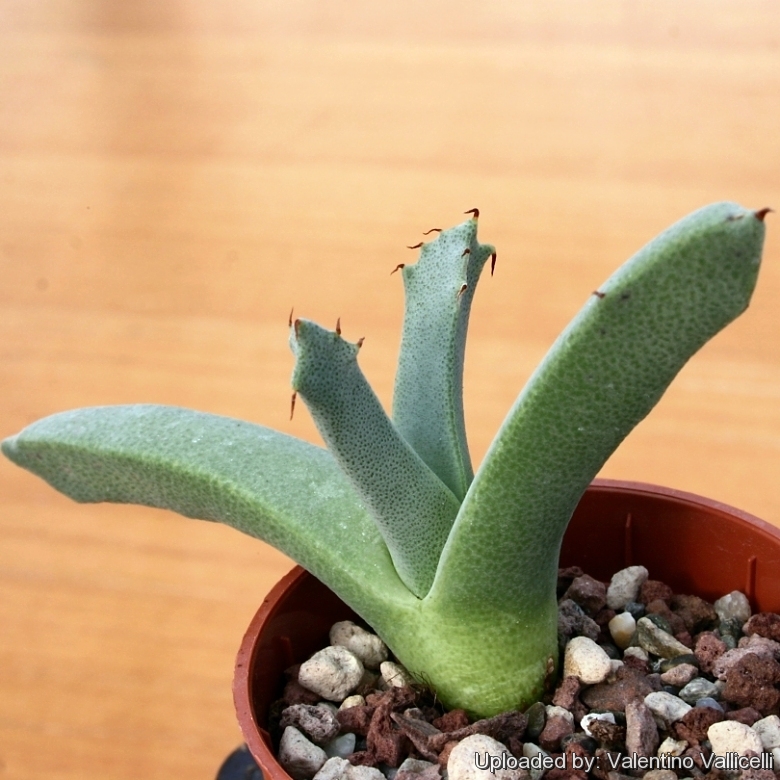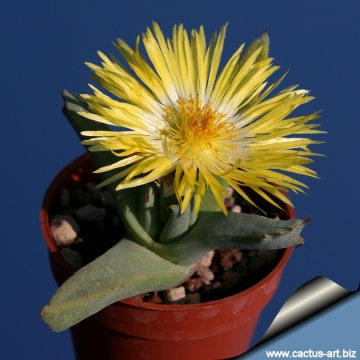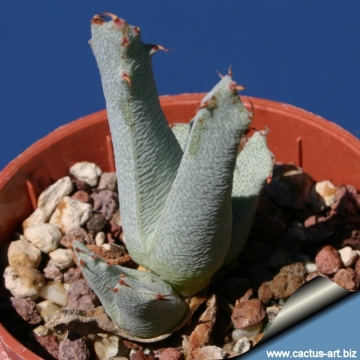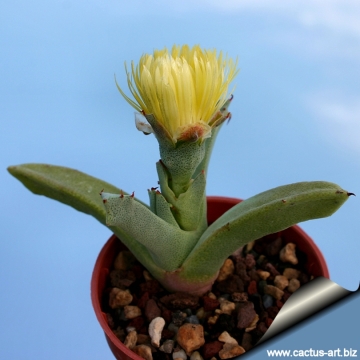Accepted Scientific Name: Odontophorus angustifolius subs. protoparcoides S.A.Hammer
Bradleya 11: 84 (1993 publ. 1994).

Odontophorus protoparcoides (Odontophorus angustifolius subs. protoparcoides) Photo by: Valentino Vallicelli
EVJ631B Rosyntjieberg (MG 1786.22)
Origin and Habitat: Northern Namaqualand, particularly in the Steinkopf area. Cape Province, South Africa.
Synonyms:
See all synonyms of Odontophorus angustifolius
Description: This is a low growing leaf succulent that forms dwarf clumps or eventually in age substantial cushion up to 50 cm in diameter.
Stems: Very short, branching, with only 4 to 6 leaves.
Leaves: Triangular, succulent with strong keel. Edges with marginal serrate teeth at tip. The surface is covered by long papillae which give the characteristic felty grey-green colour. The subspecies "protoparcoides" has been distinguished by the long blackish or dark red bristles on the leaf keel teeth and on the leaf surface.
Flowers: Solitary, sessile or shortly pedicellate, petals usually yellow or pale yellow, but also pinkish or orange in colour, often short and sub-erect.
Blooming season: Spring.
More...Subspecies, varieties, forms and cultivars of plants belonging to the Odontophorus angustifolius group
Bibliography: Major references and further lectures
1) Heidrun E. K. Hartmann “Aizoaceae F – Z” Springer, 2002
2) Hartmann. H. “Monographie der Gattung Odontophorus” Botantsche Jahrbucher 97: 161-225 (1976)
3) Jacobsen. “Handbook of succulent plants” 1328 (1960)
4) James Cullen, Sabina G. Knees, H. Suzanne Cubey “The European Garden Flora Flowering Plants: A Manual for the Identification of Plants Cultivated in Europe, Both Out-of-Doors and Under Glass - Casuarinaceae to Aristolochiaceae” Cambridge University Press, 11/ago/2011
 Odontophorus protoparcoides (Odontophorus angustifolius subs. protoparcoides) Photo by: Cactus Art
Odontophorus protoparcoides (Odontophorus angustifolius subs. protoparcoides) Photo by: Cactus Art Odontophorus protoparcoides (Odontophorus angustifolius subs. protoparcoides) Photo by: Cactus Art
Odontophorus protoparcoides (Odontophorus angustifolius subs. protoparcoides) Photo by: Cactus Art Odontophorus protoparcoides (Odontophorus angustifolius subs. protoparcoides) Photo by: Cactus Art
Odontophorus protoparcoides (Odontophorus angustifolius subs. protoparcoides) Photo by: Cactus Art Odontophorus protoparcoides (Odontophorus angustifolius subs. protoparcoides) Photo by: Cactus Art
Odontophorus protoparcoides (Odontophorus angustifolius subs. protoparcoides) Photo by: Cactus ArtCultivation and Propagation: The Odontophorus are easy to grow. Odontophorus pusillusSN|18093]]SN|18093]] seems to prefer a fairly dry rest in summer but grows whenever watered. It is easy to grow.
Soil: Requires good drainage as it it is prone to root rot. It can grows outdoor in sunny, dry, rock crevices (protection against winter wet is required) It can also be cultivated in alpine house, in poor, drained soil.
Fertilization: Feed it once during the growing season with a fertilizer specifically formulated for cactus succulents (poor in nitrogen), including all micro nutrients and trace elements diluted to ½ the strength recommended on the label. It thrives in poor soils and need a limited supplies of fertilizer to avoid the plants developing excess vegetation, which is easily attacked by fungal diseases.
Watering: They are not at all delicate and can take some water year-round. Water minimally in winter, only when the plant starts shrivelling, water more abundantly when they are growing in the autumn and spring, but let the soil dry between soaking. An occasional summer soaking is wise. If grown in a container, bottom watering by immersing the container is recommended. It must have very dry atmosphere.
Light: It needs a bright sunny or light shade exposure in winter, but keep cool and partially shaded in summer.
Hardiness: It prefer a very bright situation and require a minimum temperature 0°C (But will take frost and is hardy down to -12° C or less for short periods if is in dry soil ). USDA zones (8-)9-11. The earlier in the year they are planted, the better the chances for winter survival. True with many of the Mesembryanthemaceae.
Uses: They are hardy and they look fine in a cold greenhouse, frame, in containers or outdoor in a rockery.
Pests & diseases: They may be attractive to a variety of insects, but plants in good condition should be nearly pest-free, particularly if they are grown in a mineral potting-mix, with good exposure and ventilation. Nonetheless, there are several pests to watch for:
- Red spiders: they may be effectively rubbed up by misting the vulnerable plants every day.
- Mealy bugs: Occasianlly mealy bugs develop aerial into the new leaves and flowers with disfiguring results, but the worst types develop underground on the roots and are invisible except by their effects.
- Sciara Flies: Sciara Flies are one of the major problems for seedlings. It is a good practice to mulch your seedlings with a layer of grit, which will strongly discourage the flies.
- Scales, thrips and aphids: This insects are rarely a problem.
It is wise to treat your whole collection with a systemic insecticide twice a year in spring and autumn.
- Rot: Rot it is only a minor problem with mesembs if the plants are watered and “aired” correctly. If they are not, fungicides won't help all that much.
Propagation: Seed in spring or (or rarely) cuttings. To make a cutting twist off a branch with at least a part of roots and permit it to dry out a couple of days, lay it on the soil and insert the stem end partially into the soil. Try to keep the cutting somewhat upright so that the roots are able to grow downward.
More...















